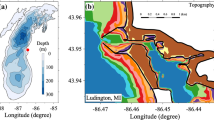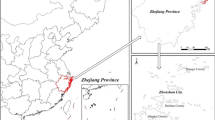Abstract
An integrated storm surge and flood inundation modeling system was developed and applied to simulate storm surges and inundation in the Gaoping River basin and its adjacent coastal area in southern Taiwan. An unstructured grid, three-dimensional hydrodynamic model was driven by the tidal elevation at the open boundaries and freshwater discharge at the upriver boundary. The model was calibrated and validated against the observed water levels for five typhoons. The results indicate a reasonable agreement between the model simulation and the observational data. A frequency analysis was used to fit the maximum surge height of historical typhoons induced by storm surges and yield the storm surge height for different return periods. The validated model was then applied to assess the potential hazard maps for different return periods as well as the influence of the sea level rise on the potential hazard maps. The typhoon-induced storm surge under the 200-year return period matched the 200-year return period peak flow, resulting in the maximum extent and depth of inundation in the low-lying area. Furthermore, the simulated results reveal that the sea level rise would enhance the flooding areas. The inundation hazard maps developed in this study could be a useful tool for planning the evacuation of residents living in low-lying areas and the decision-making of flood risk management on the coasts and floodplains.















Similar content being viewed by others
References
Arns A, Wahl T, Dangendorf S, Jensen J (2015) The impact of sea level rise on storm surge water levels in the northern part of German Bight. Coast Eng 96:118–131
Bertin X, Bruneau N, Breilh J, Fortunato AB, Karpytchev M (2012) Importance of wave age and resonance in storm surges: the case Xynthia, Bay of Biscay. Ocean Model 42:16–30
Bhaskaran PK, Gayathri R, Murty PLN, Bonthu S, Sen D (2014) A numerical study of coastal inundation and its validation for Thane cyclone in the Bay of Bengal. Coast Eng 83:104–118
Chen WB, Liu WC, Hsu MH (2012) Predicting typhoon-induced storm surge tide with a two-dimensional hydrodynamic model and artificial neural network model. Nat Hazards Earth Syst Sci 12:3799–3809
Chen CN, Tsai CH, Wu MH, Tsai CT (2015a) Numerical simulation of potential inundation in a coastal zone. J Flood Risk Manag 8:208–223
Chen WB, Liu WC, Fu HS, Jang JH (2015b) Assessing the influences of a flood diversion project on mitigating river stage, inundation extent and economic Loss. Water 7:1731–1750
Fisher RA, Tippett LHC (1928) Limiting forms of the frequency distribution of the largest and smallest member of a sample. Proc Camb Philos Soc 24:180–190
Ge J, Much D, Kappenberg J, Nino O, Ding P, Chen Z (2014) Simulating storm flooding maps over Hafen City under present and sea level rise scenarios. J Flood Risk Manag 7:319–331
Gelder PV, Neykov NM (1998) Regional frequency analysis of extreme water levels along the Dutch coast using l-moments: a preliminary study. In: International scientific conference on stochastic models of hydrological processes and their applications to problems of environmental preservation, Moscow, Russia, pp 14–20
Ghimire S (2013) Application of a 2D hydrodynamic model for assessing flood risk from extreme storm events. Climate 1:148–162
Gumbel EJ (1941) The return period of flood flows. Ann Math Stat 12:163–190
Holland GJ (1980) An analytical model of the wind and pressure profiles in hurricanes. Mon Weather Rev 108:1212–1218
Horritt MS, Bates PD, Mattinson MJ (2006) Effects of mesh resolution and topographic representation in 2D finite volume models of shallow water fluvial flow. J Hydrol 329:306–314
Huang W, Xu S, Nnaji S (2008) Evaluation of GEV model for frequency analysis of annual maximum water levels in the coastal of United States. Ocean Eng 35:1132–1147
Hubbert GD, Holland GJ, Leslie LM, Manton MJ (1991) A real-time system for forecasting tropical cyclone storm surges. Weather Forecast 6:86–97
Katsman CA, Hazeleger W, Drijfhout SS, van Oldenborgh GJ, Burgers G (2008) Climate scenarios of sea level rise for the northeast Atlantic Ocean: a study including the effects of ocean dynamics and gravity changes induced by ice melt. Clim Change 91:351–374
Katsman CA, Sterl A, Beersma JJ, van den Brink HW, Church JA, Hazeleger W, Kopp RE, Kroon D, Kwadijk J, Lammersen R, Lowe J, Oppenheimer M, Plag HP, Ridley J, von Storch H, Vaughan DG, Vellinga P, Vermeersen LLA, van de Wal RSW, Weisse R (2011) Exploring high-end scenarios for local sea level rise to develop flood protection strategies for a low-lying delta-The Netherlands as an example. Clim Change 109:617–645
Large WG, Pond S (1981) Open ocean momentum flux measurements in moderate to strong winds. J Phys Oceanogr 11:324–336
Leichenko RM, Thomas A (2012) Coastal cities and regions in a changing climate: economic impacts, risks and vulnerabilities. Geogr Compass 6:327–339
Liu H, Zhang K, Li Y, Xie L (2013) Numerical study of the sensitivity of mangroves in reducing storm surge and flooding to hurricane characteristics in southern Florida. Cont Shelf Res 64:51–65
Lopes CL, Dias JM (2015) Assessment of flood hazard during extreme sea levels in a tidally dominated lagoon. Nat Hazards 77:1345–1364
Management Committee for Gaoping River basin (2012) The 2012 annual report on the management and implementation of Gaoping river basin (in Chinese)
Milliman JD, Kao SJ (2005) Hyperpycnal discharge of fluvial sediment to the ocean: impact of super-typhoon Herb (1996) on Taiwanese Rivers. J Geol 113:503–516
Nicholls RJ, Cazenave A (2010) Sea-level rise and its impact on coastal zones. Science 328:1517–1520
Nicholls RJ, Marinova N, Lowe JA, Brown S, Vellinga P, de Gusmao D, Hinkel J, Tol RSJ (2011) Sea-level rise and its possible impacts given a beyond 4 °C world in the twenty-first century. Philos Trans R Soc A 369:161–181
Powell MD, Vickery PJ, Reinhold TA (2003) Reduced drag coefficient for high wind speeds in tropical cyclones. Nature 422:279–283
Proshutinsky A, Pavlov V, Brourke RH (2001) Sea level rise in the Artic Ocean. Geophys Res Lett 28:2237–2240
Rahmstorf S, Cazenave A, Church JA, Hansen JE, Keeling RF, Parker DE, Somerville RCJ (2007) Recent climate observations compared to projections. Science 316:709
Rao AD, Murty PLN, Jain I, Kankara RS, Dube SK, Murty TS (2013) Simulation of water levels and extent of coastal inundation due to a cyclonic storm along the east coast of India. Nat Hazards 66:1431–1441
Sobey RJ (2005) Extreme low and high water levels. Coast Eng 52:63–77
Tsimplis MN, Blackman D (1997) Extreme sea-level distribution and return periods in the Aegean and Ionian seas. Estuar Coast Shelf Sci 44:79–89
Vermeer M, Rahmstorf S (2009) Global sea level linked to global temperature. PNAS 106:21527–21532
Walton TLJ (2000) Distributions for storm surge extremes. Ocean Eng 27:1279–1293
Wang RM, You CF, Chu HY, Hung JJ (2009) Seasonal variability of dissolved major and trace elements in the Gaoping (Kaoping) River Estuary, Southwestern Taiwan. J Mar Syst 76:444–456
Weibull W (1951) A statistical distribution function of wide applicability. J Appl Mech 18:293–297
Woodruff JD, Irish JL, Camargo SJ (2013) Coastal flooding by tropical cyclones and sea-level rise. Nature 504:44–52
Xie L, Kiu H, Liu B, Bao S (2011) A numerical study of the effect of hurricane wind asymmetry on storm surge and inundation. Ocean Model 36:71–79
Xu S, Huang W (2008) Frequency analysis for prediction 1 % annual maximum water levels along Florida coast, US. Hydrol Process 22:4507–4518
Yoon JJ, Shim JS (2013) Estimation of storm surge inundation and hazard mapping for the southern coast of Korea. J Coast Res 65:856–861
Zhang YL, Baptista AM (2008) SELFE: a semi-implicit Eulerian–Lagrangian finite-element model for cross-scale ocean circulation. Ocean Model 21:71–96
Zu T, Gana J, Erofeevac SY (2008) Numerical study of the tide and tidal dynamics in the South China Sea. Deep-Sea Res I 55:137–154
Acknowledgments
The project was funded by the Ministry of Science and Technology, Taiwan, Grant No. 103-2625-M-239-001. The authors would like to express their appreciation to the Taiwan Center Weather Bureau and the Water Resources Agency for providing the observational data. The authors also sincerely thank two anonymous reviewers for their valuable comments.
Author information
Authors and Affiliations
Corresponding author
Rights and permissions
About this article
Cite this article
Chen, WB., Liu, WC. Assessment of storm surge inundation and potential hazard maps for the southern coast of Taiwan. Nat Hazards 82, 591–616 (2016). https://doi.org/10.1007/s11069-016-2199-y
Received:
Accepted:
Published:
Issue Date:
DOI: https://doi.org/10.1007/s11069-016-2199-y




